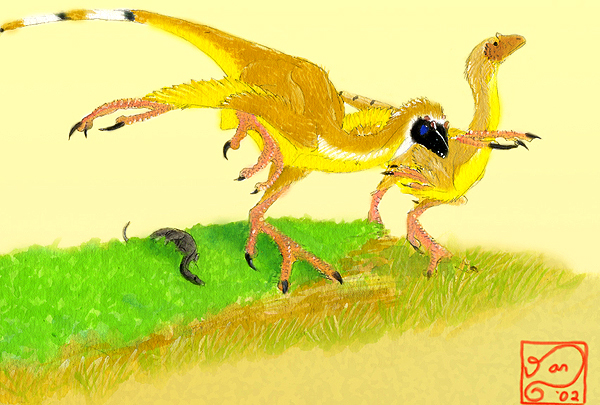

Deinonychosaurs, those versatile, predatory near-birds, have enjoyed enormous successes throughout the latter part of the Mesozoic and the Tertiary. However, diversification of form within this clade has been stunted by the demands of a deinonychosaur's life. Even tiny changes to their anatomy would result in a creature that would not be able to feed itself, and so the deinonychosaur form has stagnated, not changing appreciably in more than 100 million years.There are exceptions to the rule, of course, aberrant forms that differ greatly from their progenitors and still function as organisms. One of these creatures is the djanada (Janaata russelae). Djanada live only in the cloud forests of northern South America, where moisture trapped by the rising Andes rains onto a canopy that stretches across the horizon. As lush as the Amazon, but somewhat cooler, the cloud forests are biological islands, isolated from the rest of the continent by the mountains.
The djanada is a small animal, never longer than two meters, and very lightly built, with long neck and tail and large, nimble hands. Most noteworthy, though, are a djanada's feet. The famous hypextendable inner toes of the deinonychosaurs have been twisted almost completely around, and now oppose the other two toes to create a powerful grasping organ. A djanada's pedal grip comes in useful for climbing trees, but is also a useful hunting tool. The predators may stand balanced on a single foot on the shadowed forest floor, or in a small stream, and wait for a small animal to happen past. When a djanada sees such a victim, it slams its foot down, pinning the hapless creature to the ground.
Because of their opposable toes, some scholars have allied djanada to the arboronychosaurs, however the creatures' internal anatomy (most notably their lack of visible hallux claws) negates this assumption. Instead, djanada are placed in their own family, Janaatidae, a sister group to Hesperonychidae, from which the djanada are undoubtedly derived.